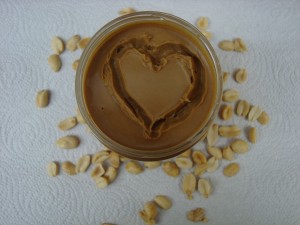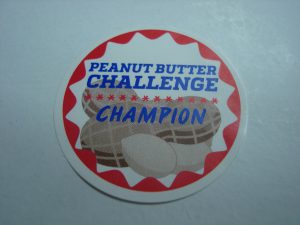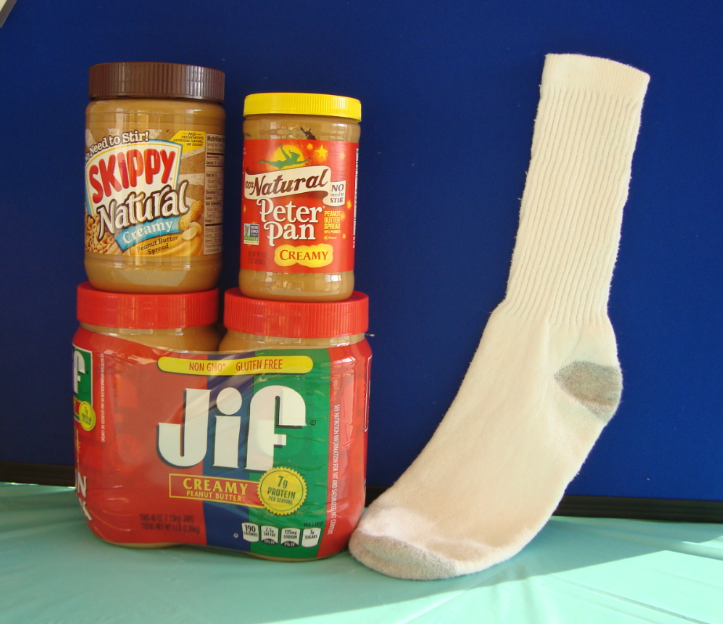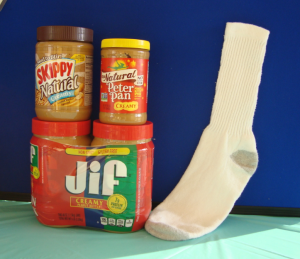
by Angela Hinkle | Oct 27, 2020
The year 2020 has certainly been one filled with challenges. But unlike the challenges of sickness, social distancing, economic hardships, and hurricanes, the 2020 Peanut Butter Challenge offers helpful, feel-good relief.

Nutty for Peanut Butter
Photo Source: Angela Hinkle
Throughout Florida, the 2020 Peanut Butter Challenge assists families who could really use some help.
Why
Peanut butter is one of the most requested foods for food pantries and food distribution sites. It’s food-safe at room temperature. You don’t need electricity to keep it hot or cold. People like the taste (although creamy texture is usually preferred over crunchy). Peanut butter can be eaten by itself or spread on crackers or bread or mixed into a smoothie or used to make a satay to go with noodles or chicken. It’s a quick and easy protein source. Peanut butter provides other nutrients our bodies need, like fiber and iron. And, economically speaking, peanut butter easily fits into a modest grocery budget.
When
The 2020 Peanut Butter Challenge runs until the day before Thanksgiving – this year, November 25th. You still have plenty of time, although why delay such a great opportunity? Of course, peanut butter makes a great gift to food pantry and distribution sites all year long.
How

Peanut Butter Challenge Champion
Photo Source: Angela Hinkle
UF/IFAS Extension Offices throughout the Florida Panhandle are collection sites for unopened jars of peanut butter. Bring as many jars as you would like. An agent in your local Extension Office can also direct you to a variety of other peanut butter donation sites. Next time you shop, look for a Buy-one Get-one offer. Donate one and keep one for yourself. Or just pick up a couple extra jars, knowing you may really be helping a family in need.
Who Benefits
Once all the jars of peanut butter are collected, they are then redistributed to local food pantry and distribution sites. Families in need going to those sites benefit with an easy, tasty, quick, healthy way to provide for those in their care. You feel satisfied knowing you found a great way to help a neighbor.
So this year, give the gift of a few jars of peanut butter and conquer the 2020 Peanut Butter Challenge.

by Angela Hinkle | Oct 9, 2018

Peanut Butter Challenge
Photo Source: UF/IFAS Extension Escambia
What would you do with 10,000 pounds of Peanut Butter? How about change the lives of hungry families.
What’s It All About?
The annual Peanut Butter Challenge has begun for 2018. Unopened jars of peanut butter are collected throughout the Florida Panhandle. We do this until the Tuesday before Thanksgiving at area Peanut Butter Challenge donation drop-off sites. Local peanut farmers help to match contributions. The peanut butter is then donated to local food pantries and food banks to help struggling families. Last year, the Peanut Butter Challenge collected about 9,000 pounds of peanut butter. This year, the goal is to collect 10,000 pounds of Peanut Butter. Five tons – whew, that’s a lot!
Why Is It Important?
When families are not sure where and when they will get healthy food to eat, they are considered to be food insecure. Many of these families rely on food pantries to supplement their dietary needs. Peanut butter is the most requested food in most pantries. It is loaded with protein and other good-for-you nutrients like fiber and potassium. Peanut butter is shelf stable – no need to heat or keep cold. Most people really like the taste of it. So…basically, a super food.
What is the Easiest Way for Me to Help?

Nutty for Peanut Butter
Photo Source: Angela Hinkle
Though peanut butter is very economical, (usually about $2.50 per pound), look at the sales ads. Almost every week, some place has peanut butter on sale. Better yet, look for the buy one, get one free specials. Keep one jar for yourself and donate a jar. Then take your peanut butter to the closest Peanut Butter Challenge collection site.
Where Can I Contribute or Find Out More?
To find out where to donate unopened jars of peanut butter in your area, contact your local Northwest District UF/IFAS Extension office.
Help UF/IFAS Extension and the Peanut Butter Challenge donate 10,000 pounds of peanut butter to help take a bite out of hunger for local families in need. Oh, and we’ll do the heavy lifting.
For more information on how UF/IFAS Extension faculty are working to provide food access to more people and stem this tide of hunger, read Nick Place on 2018 PBC.

by Angela Hinkle | Aug 23, 2018

Healthy Pantry
Photo Source: Angela Hinkle
We eat to survive, right? Yes, but when you really think about it, we eat to thrive. Food is more than calories for energy. Food brings family and friends together. It provides comfort. It makes our bodies healthy and can protect us from diseases. The next time you give to a food pantry, think about what you can give to help those in need thrive, not just survive. So, how do you donate food to thrive?
A Balanced Diet
It’s important to eat from every food group every day. It’s important to give those in need the chance to eat every food group every day. This way, they get a variety of nutrients needed for healthy bodies. Choose healthier choices from each food group. See https://www.choosemyplate.gov/ for more information.
Fruits & Veggies: Half MyPlate
- Fruits and vegetables provide so many good vitamins, minerals, fiber, and water.
- All forms count – canned, frozen, fresh, dried, and juice.
- Canned fruit in 100% juice (Lite or heavy syrup equals a little or a lot of added sugar.)
- Juices that are 100% fruit or vegetables.
- Low- or no-sodium canned vegetables (Higher sodium intake tends to go hand-in-hand with higher blood pressure.)
- Try to stay away from high-fat, high-sodium, and high-sugar syrups and sauces.
- Packaged dried fruits and veggies are both popular now.
- The more fruits and vegetables, the better!
Whole Grains
- The whole edible part of the grain plant gives us fiber and loads of nutrients to keep us healthy. They even have special parts that help fight diseases.
- Look for the word whole at the beginning of the ingredient list.
- Help pantries stock whole grain crackers, hot and cold cereals, and tortillas. Donate whole grain pasta and brown rice.
Lean Proteins
- Protein helps build and repair tissue.
- Protein provides the building blocks of muscles, bones, skin, and blood.
- Go for lower-sodium and lower-fat choices. (Most of us over the age of two don’t need that extra fat.)
- Donate tuna, chicken, or salmon in water.
- Peanut butter is always popular.
- Try offering a variety of packaged seeds and nuts.
Dairy
- The calcium in dairy foods makes strong bones and teeth.
- Try low-fat versions of shelf-stable milk.
- Non-fat dry milk is great for sauces and casseroles as well as drinking. (If used for drinking, it tastes best to add the coldest water possible.)
- Low-fat yogurt and cheeses are a nice complement for pantries with refrigeration.
- For those who can’t have dairy, offer calcium-fortified soy or almond milk, cereal, or orange juice.
So don’t just think “feed them” when you donate, think “feed them well.” Donate beyond survive. Donate to thrive.

by Angela Hinkle | Oct 19, 2016
 It’s that time of year: going to Friday night football games, decorating with pumpkins, welcoming in some cooler weather, and harvesting our locally grown peanuts and cotton. This also means it’s time for the Peanut Butter Challenge. We collect jars of unopened peanut butter throughout the Northwest Panhandle of Florida through November 23rd. (Contact your local UF/IFAS Extension office for details and peanut butter drop-off sites.)
It’s that time of year: going to Friday night football games, decorating with pumpkins, welcoming in some cooler weather, and harvesting our locally grown peanuts and cotton. This also means it’s time for the Peanut Butter Challenge. We collect jars of unopened peanut butter throughout the Northwest Panhandle of Florida through November 23rd. (Contact your local UF/IFAS Extension office for details and peanut butter drop-off sites.)
Peanut butter is a locally grown (okay, we don’t actually grow peanut butter, but we do grow the peanuts that make peanut butter), protein packed, tasty food that is safe to eat and store at room temperature. For these reasons, it is one of the most requested items at food pantries. After Thanksgiving, we will distribute to food pantries and organizations that give food to hungry families in need.
Okay, so what role do socks play in this? Cotton, another great locally grown agricultural product, is used to make socks. And even though UF/IFAS Extension does not have a “Sock Challenge,” the homeless and limited-resource families are often in desperate need of new white socks. There are plenty of shelters and schools who would really appreciate donations of clean new socks – any time of year.
So…Peanut Butter and Socks – they really are the Florida Panhandle’s perfect combination!







